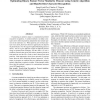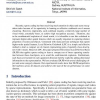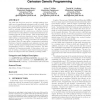470 search results - page 39 / 94 » Using Unknown Word Techniques to Learn Known Words |
ICDAR
2003
IEEE
14 years 2 months ago
2003
IEEE
Classifying an unknown input is a fundamental problem in pattern recognition. A common method is to define a distance metric between patterns and find the most similar pattern i...
BMVC
2010
13 years 7 months ago
2010
Recently, sparse coding has been receiving much attention in object and scene recognition tasks because of its superiority in learning an effective codebook over k-means clusterin...
GECCO
2007
Springer
14 years 3 months ago
2007
Springer
The brain has long been seen as a powerful analogy from which novel computational techniques could be devised. However, most artificial neural network approaches have ignored the...
SPIRE
1998
Springer
14 years 1 months ago
1998
Springer
Stemming is a technique which aims to extract common suffixes of words. Thus, words which are literally differhave a common stem, may be abstracted by their common stem. The under...
CHES
2005
Springer
14 years 2 months ago
2005
Springer
We describe a new variant of the well known Baby-Step Giant-Step algorithm in the case of some discrete logarithms with a special structure. More precisely, we focus on discrete lo...



